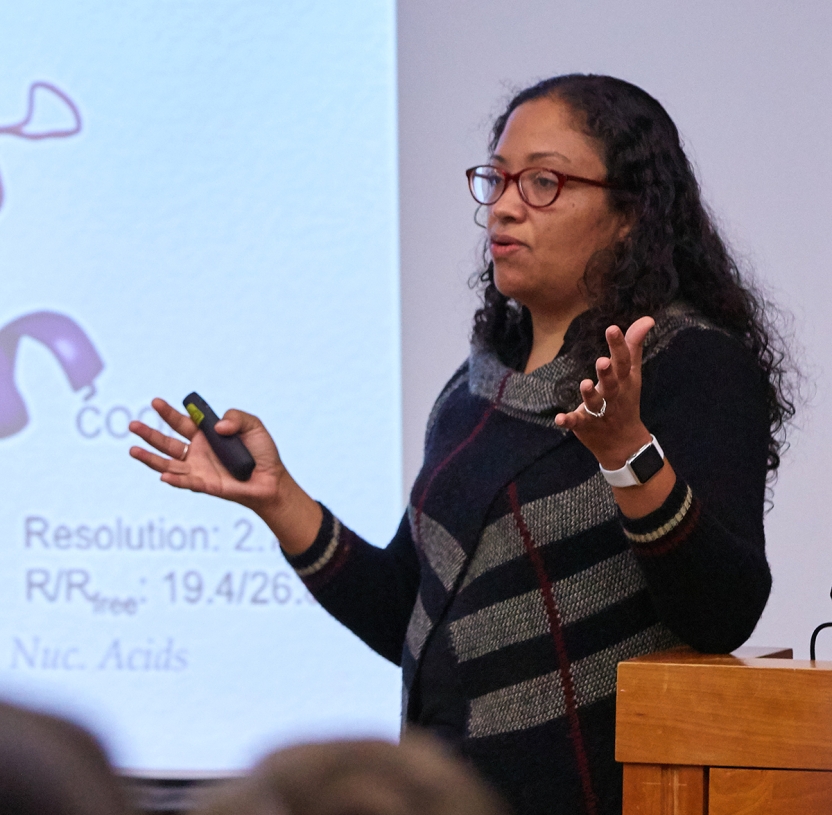University of Maryland Scientist Nicole LaRonde Gives Second Freeman Lecture in the Sciences

MIDDLEBURY, Vt. – Middlebury students and faculty made their way through last Friday’s first bitter cold to McCardell Bicentennial Hall for the Martin H. Freeman lecture, the second in an annual series designed to bring speakers in STEM fields from underrepresented groups to campus. This year’s speaker, University of Maryland Department of Chemistry and Biochemistry Professor Nicole LaRonde, shared her latest research in biophysical chemistry and also sat down to dinner and lunch with students to discuss their concerns and share her own experiences.
LaRonde studies protein structures using a method called x-ray crystallography. By growing protein crystals and then firing x-rays through them, LaRonde is able to understand protein structures in three dimensions. Her talk focused on a particular protein group, the RIO kinases. Kinases, LaRonde explained in an interview, interact with ribosomes, a part of cells responsible for making proteins, as the ribosomes are being made during cell division.
“Ribosome biogenesis is a very important process because all proliferating cells need ribosome biogenesis in order to divide because you need to make more ribosomes to make daughter cells, and you need to outfit them with new ribosomes but you also need to make new proteins, and so it’s a very important process in anything where you have rapid cell division,” LaRonde noted.
Because of their importance in rapid cell division, RIO kinases are a focus of anti-cancer drug development, including for ovarian cancer, LaRonde said. A dividing cell spends 70-80 percent of its energy in making ribosomes, and RIO kinases are involved in that process, she said. “So it’s really about understanding this fundamental biological process that’s very important for cells.”
The types of kinases LaRonde focused on during her talk, RIO1 and RIO2, actually behave quite differently from other kinases – a surprise, LaRonde said. Though they share a basically similar structure, RIO kinases have a different way of interacting with energy-providing molecules in the cell when ribosomes are being manufactured. And RIO1 and RIO2 kinases have existed for billions of years. This means that understanding how they work may shed light on the origins of certain cellular functions. The unexpected result is also a larger lesson about science, LaRonde pointed out.
“When you go into an experiment expecting something, sometimes it stands in the way of finding new things,” LaRonde said.
LaRonde and her team were the first to reveal the unusual behavior of these proteins, as well as the first to uncover the structures of RIO kinases, she said.
LaRonde also discussed two genes that Middlebury College students are studying in their classes. The work she and her colleagues are doing on these genes’ structures will change what’s in textbooks the students read in the future, she said.
Lesley-Ann Giddings, assistant professor of chemistry and biochemistry, who organized the event, said she created the lecture series to provide role models for science, technology, engineering and math students of color at Middlebury, noting that she began to visualize the speaker series as a new faculty member in 2015.
“Seeing that there aren’t that many students of color in STEM, how could we bring more role models here for them and also, while doing that, get other students to recognize the diversity that exists in STEM?” Giddings wondered. A trip to the college archives in the library basement in search of records on underrepresented Middlebury College students inspired the series’ name, Giddings said, when she learned about the career of Middlebury class of 1849 alumnus Martin Henry Freeman. The salutatorian of his class, Freeman went on to become a mathematician, professor and the first African-American president of a college, Giddings said.
“Based on his career path and being an educator and pioneer, I thought that the lecture would be best if it was named after him… as we’re trying to celebrate some of the top scholars in industry, academia, the government, from these historically underrepresented groups in STEM,” Giddings added.
“I’m very honored to be able to do this [lecture],” LaRonde said. “It’s in recognition of Martin Freeman, who… was a pioneer in educating black students at a time when it was difficult for them to access higher education, and that’s one of my goals as a faculty member, a woman faculty member of color.” Encouraging students through the process of pursuing a scientific education and career have been long-term goals of hers, LaRonde noted.
By Lauren Milideo; Photo by Todd Balfour

